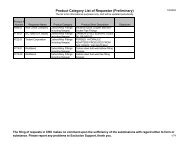E-Commerce Commission Press Kit
E-Commerce Commission Press Kit
E-Commerce Commission Press Kit
You also want an ePaper? Increase the reach of your titles
YUMPU automatically turns print PDFs into web optimized ePapers that Google loves.
estimates that streamlining these purchases alone could save the company $500-$700 million overthe next three years. 43Other companies report plans to use the Internet for procurement. One out of four purchasingmanagers expects to use the Internet for MRO purchases, up from 10 percent who use it for thatpurpose today. 44REDUCED INVENTORY/THE RIGHT PRODUCTS IN STOCKThe longer it takes for production schedules to reach suppliers, the more inventory a company hasto hold to account for delays and errors, and the less quickly it can react to changes in demand.The more inventory a company holds, the higher its operating costs, and the lower its profits.Carrying more inventory does not ensure better customer service, either. Shelves weighed downwith size-10 running shoes do not help the customer who wears a size 8. When a customer entersa furniture showroom looking for an armchair with green and white stripes and is told it’s onback-order for 12 weeks, he may drive across town to a competitor rather than wait.Managing inventory properly results in better service for the customer and lower operating costsfor the company. Increasing the frequency of inventory “turns” (the number of times inventory inexisting warehouse or store space is sold or used for production each year) reduces inventoryrelatedinterest, handling and storage costs. Reducing inventory levels also means that existingmanufacturing capacity is more efficiently utilized. More efficient production can reduce oreliminate the need for additional investments in plant and equipment.IBM’s Personal Systems Group provides an illustration of how the Internet and private networksare helping companies keep stocks of inventory smaller, yet more targeted on likely consumerneeds.Each month, the group’s marketing departments report information on how many PCs they thinkwill be sold. The production planning departments identify manufacturing and materials capacityin each factory. Armed with inputs from across the company on demand and supply, productionschedules are assigned to each factory. The procurement staff uses the same information tonegotiate with suppliers. As new information comes in each week, the process is repeated and theproduction schedule fine-tuned.Electronic communication between factories, marketing and purchasing departments have madethis quick response possible. Problems are communicated as they arise and the appropriateadjustments are made. If demand suddenly rises or if one factory cannot meet its productionschedule, IBM is aware of it in time to increase production at another factory.The Personal Systems Group has been phasing in this Advanced Planning System (APS) since1996 and already reports significant results. During the first year of APS, inventory turns15
















